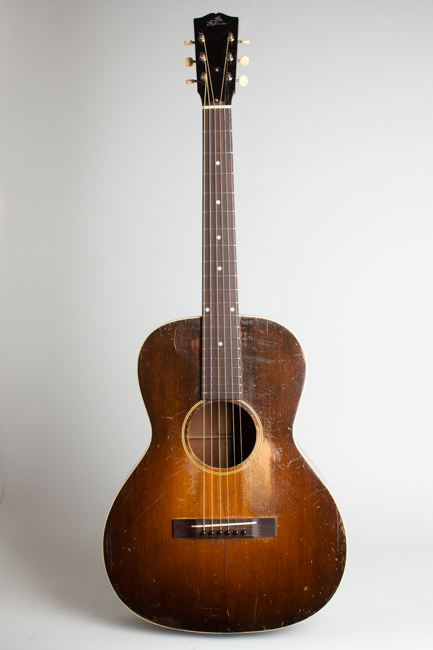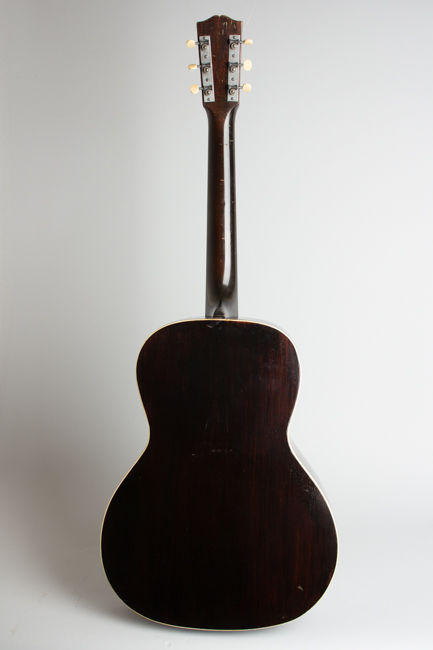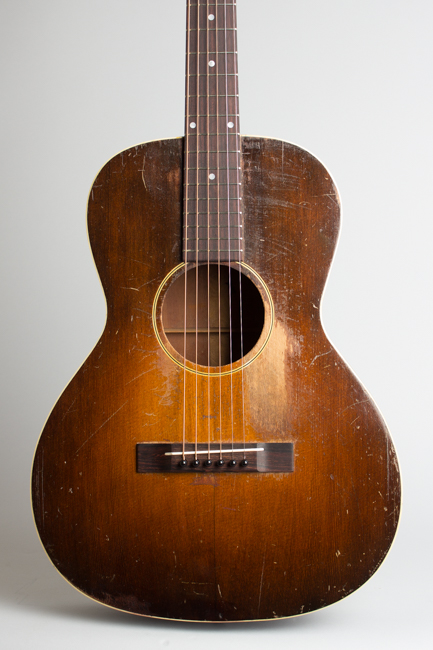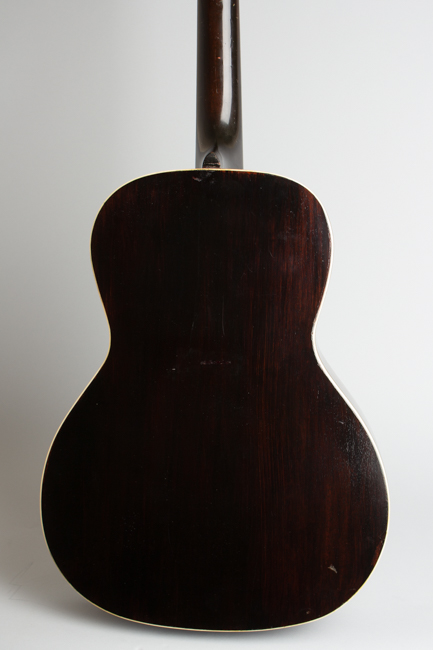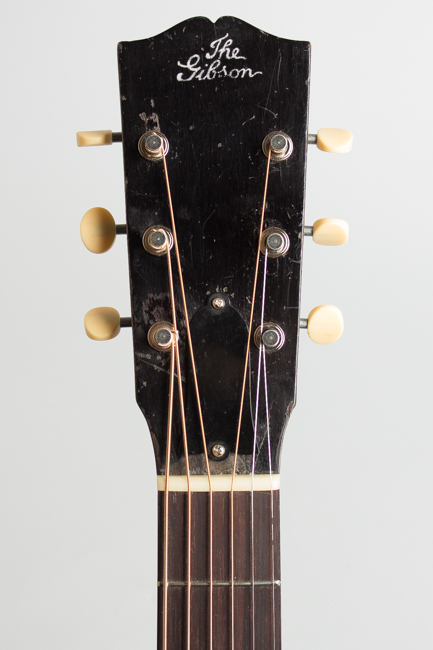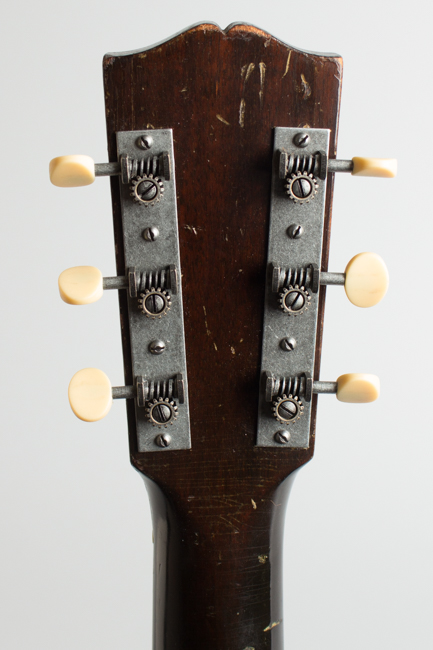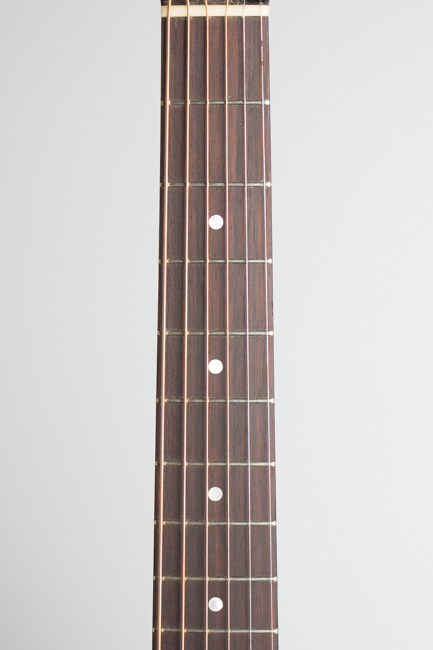Gibson L-1 Flat Top Acoustic Guitar (1930)
This item has been sold.
Item # 7980
Prices subject to change without notice.
Gibson L-1 Model Flat Top Acoustic Guitar (1930), made in Kalamazoo, Michigan, serial # 9756 (FON), sunburst top, dark back and sides finish, mahogany back and sides, spruce top; mahogany neck with rosewood fingerboard, black hard shell case.
This model is a well-worn but nice playing example of a particularly rare and wonderful Gibson flat-top only produced for a brief period from 1929-31. This 1930 L-1 combines features from earlier and later eras into a unique package, with the elegant look of the 1920s Gibsons on the structure of a more "modern" 1930s flat-top guitar.
The larger, less rounded-bout body and X-braced top first seen on this model would be subsequently used on similar 14-fret L-series guitars throughout the 1930s, but the older hand-rubbed Cremona brown sunburst finish on the top and small script "The Gibson" logo on the headstock were gone by 1932.
These 12-fret L-1s feature exceptionally light construction, even compared to other pre-war Gibsons like the far more common mid-1930s examples. The X bracing is very light, with thinner main braces than even Martin used at the time. While we are partial to all pre-WWII Gibson flat-tops, we still find the L-1 from this year to be a particularly attractive-looking (and great-sounding) guitar.
These relatively fragile 12-fret 14 3/4" L-1s were made in fairly limited numbers, with Gibson sales blighted by the growing Depression even as they were introduced. Every survivor we have found has proved a gem, even in well-used condition like this one.
Overall length is 38 1/2 in. (97.8 cm.), 14 3/4 in. (37.5 cm.) wide at lower bout, and 4 1/4 in. (10.8 cm.) in depth at side, taken at the end block. Scale length is 24 3/4 in. (629 mm.). Width of nut is 1 3/4 in. (44 mm.).
This venerable L-1 has been quite heavily played but remains a wonderful historic instrument and an exceptionally fine playing and sounding guitar. It has had a recent full overhaul including a neck set, new Brazilian rosewood fingerboard, period-style frets, repro slightly oversize bridge, and correct small maple bridgeplate.
There is a very cleanly repaired split through the endpin area (but not through the heel block), a repaired grain crack on the back off the center, and two repaired spruce grain cracks to the top, one off the back edge and another just at the edge of the lower treble bout.
The back of the guitar has been oversprayed dark, as has the length of the back of the neck down into the heel area. This appears to have been done some time ago, as there is wear to this finish. There is either a deep scratch or old grain split on the back of the neck between frets 6 and 9, difficult to judge exactly as it has been sprayed over.
The sides and top retain their original lacquer finish, as does the headstock face, with the top showing the largest amount of wear. This includes a decent sized spot through the finish into the wood below the strings, with smaller spots of strumwear above the strings behind the sound hole and on both sides of the fingerboard as well. The tuners are new repros (the originals were long gone) that work very well without adding any extra weight to this extraordinarily light guitar.
This veteran guitar is perhaps not a collector's piece, but it has a sound for the ages and carries a lot of history. It currently resides in a 1960s-1970s hard case that is adorned with colorful vintage stickers indicating travels around the American southwest. We'd love to know where this old guitar has been, but likely never will...still, we hope it will go on to have more adventures making music as it comes closer to its second century of existence! Very Good + Condition.
This model is a well-worn but nice playing example of a particularly rare and wonderful Gibson flat-top only produced for a brief period from 1929-31. This 1930 L-1 combines features from earlier and later eras into a unique package, with the elegant look of the 1920s Gibsons on the structure of a more "modern" 1930s flat-top guitar.
The larger, less rounded-bout body and X-braced top first seen on this model would be subsequently used on similar 14-fret L-series guitars throughout the 1930s, but the older hand-rubbed Cremona brown sunburst finish on the top and small script "The Gibson" logo on the headstock were gone by 1932.
These 12-fret L-1s feature exceptionally light construction, even compared to other pre-war Gibsons like the far more common mid-1930s examples. The X bracing is very light, with thinner main braces than even Martin used at the time. While we are partial to all pre-WWII Gibson flat-tops, we still find the L-1 from this year to be a particularly attractive-looking (and great-sounding) guitar.
These relatively fragile 12-fret 14 3/4" L-1s were made in fairly limited numbers, with Gibson sales blighted by the growing Depression even as they were introduced. Every survivor we have found has proved a gem, even in well-used condition like this one.
Overall length is 38 1/2 in. (97.8 cm.), 14 3/4 in. (37.5 cm.) wide at lower bout, and 4 1/4 in. (10.8 cm.) in depth at side, taken at the end block. Scale length is 24 3/4 in. (629 mm.). Width of nut is 1 3/4 in. (44 mm.).
This venerable L-1 has been quite heavily played but remains a wonderful historic instrument and an exceptionally fine playing and sounding guitar. It has had a recent full overhaul including a neck set, new Brazilian rosewood fingerboard, period-style frets, repro slightly oversize bridge, and correct small maple bridgeplate.
There is a very cleanly repaired split through the endpin area (but not through the heel block), a repaired grain crack on the back off the center, and two repaired spruce grain cracks to the top, one off the back edge and another just at the edge of the lower treble bout.
The back of the guitar has been oversprayed dark, as has the length of the back of the neck down into the heel area. This appears to have been done some time ago, as there is wear to this finish. There is either a deep scratch or old grain split on the back of the neck between frets 6 and 9, difficult to judge exactly as it has been sprayed over.
The sides and top retain their original lacquer finish, as does the headstock face, with the top showing the largest amount of wear. This includes a decent sized spot through the finish into the wood below the strings, with smaller spots of strumwear above the strings behind the sound hole and on both sides of the fingerboard as well. The tuners are new repros (the originals were long gone) that work very well without adding any extra weight to this extraordinarily light guitar.
This veteran guitar is perhaps not a collector's piece, but it has a sound for the ages and carries a lot of history. It currently resides in a 1960s-1970s hard case that is adorned with colorful vintage stickers indicating travels around the American southwest. We'd love to know where this old guitar has been, but likely never will...still, we hope it will go on to have more adventures making music as it comes closer to its second century of existence! Very Good + Condition.
